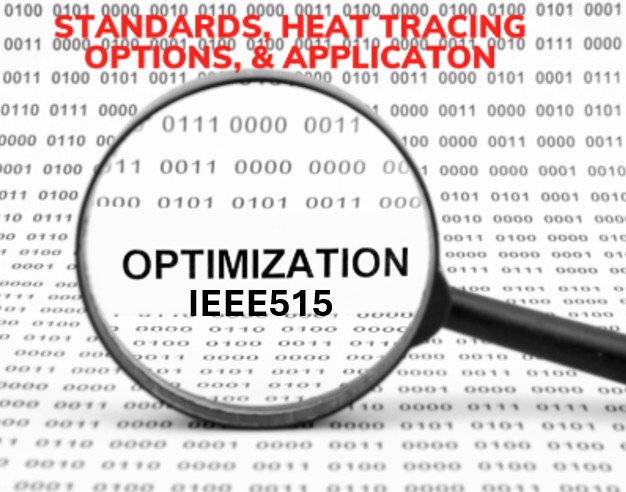Standards, Heat Tracing Options, & Application Optimization – IEEE515

1. Testing & Qualification
- Dielectric Strength & Insulation Integrity — Perform high-potential (Hi-Pot) testing to verify the insulation can withstand the rated voltage without breakdown, while maintaining safe insulation resistance (IR) values.
- Thermal Endurance & Temperature Rating — Verify the cable and all components can withstand the maximum rated temperature. Includes thermal cycling tests to evaluate long-term degradation from repeated heat/cool cycles.
- Mechanical Robustness — Test bending, impact, tensile strength, and thermal expansion/contraction to ensure the cable survives vibration and physical stress during installation and service.
- Moisture & Chemical Resistance — Evaluate resistance to water ingress and chemical exposure for durability in corrosive or humid industrial environments.
- Termination & Splice Testing — Confirm end seals, junctions, and splices maintain electrical insulation and proper heat transfer performance.
2. System Design
- Heat Loss & Heat Load Calculation — Calculate heat loss from pipes or vessels based on insulation thermal conductivity, ambient minimum temperature, wind, and safety factors.
- Cable Sizing & Power Density — Select appropriate cable type (series resistance, parallel, self-regulating) and specify wattage per unit length (W/m) to maintain process temperature without exceeding sheath limits.
- Circuit Length & Voltage Drop — Determine maximum circuit length to avoid excessive voltage drop that would reduce heating performance.
- Control Philosophy — Define control strategy (on/off, ambient sensing, line sensing, electronic controllers) to maintain target temperature and optimize energy use.
- Hazardous Area Compliance — Choose cables and components certified for Class/Division or Zone designations when installed in classified hazardous atmospheres.
3. Installation Practices
- Surface Preparation & Attachment — Clean and prepare pipe or vessel surfaces; secure cables with tape, bands, or aluminum foil for efficient heat transfer and mechanical stability.
- Routing & Spacing — Lay out cables in the designed pattern (straight, spiral, multiple passes) with correct spacing to control heat density.
- Moisture Protection & Sealing — Use approved terminations and splices to prevent moisture ingress and electrical faults.
- Identification & Documentation — Label traced lines, tag circuits, and maintain accurate as-built records for future maintenance.
- Thermal Insulation Integration — Apply thermal insulation only after cable installation is complete, ensuring cables are not crushed or displaced.
4. Control & Monitoring
- Temperature Control Strategies — Use thermostats, RTDs, electronic controllers, or PLC/DCS systems for single-point or multi-point temperature regulation.
- Ground-Fault Protection — Provide ground-fault equipment protection (GFEP) to prevent shock hazards and improve system safety.
- Circuit Protection & Coordination — Select breakers and fuses to handle self-regulating cable inrush current while coordinating with upstream power systems.
- System Health Monitoring — Implement current monitoring or insulation resistance monitoring for early warning of circuit degradation.
5. Maintenance & Periodic Inspection
- Pre-commissioning Tests — Measure conductor resistance and insulation resistance before energizing new circuits.
- Scheduled IR Testing — Periodically re-measure insulation resistance and trend against baseline to detect deterioration.
- Visual & Physical Inspection — Check for mechanical damage, moisture ingress, loose connections, or compromised thermal insulation.
- Corrective Actions & Records — Repair or replace degraded components and update as-built drawings and maintenance logs.
- Seasonal Start-Up Checks — For cold-weather operations, verify system readiness before each winter season.
6. Hazardous / Classified Locations
- Area Classification Compliance — Follow Class I Division 1/2 or Zone 1/2 rules per NEC, IEC, or ATEX when designing for explosive atmospheres.
- Cable & Component Certification — Use only cables and accessories tested and certified (Ex, FM, UL, CSA) for the appropriate hazardous area.
- Sealing & Termination Integrity — Ensure terminations prevent the passage of flammable gases or vapors into electrical components.
- Thermal Limitation — Respect T-Rating (temperature class) limits so the cable’s maximum surface temperature does not exceed the ignition temperature of nearby gases or chemicals.
- Documentation & Inspection — Maintain compliance certificates, installation drawings, and perform inspections as required by the authority having jurisdiction (AHJ).
